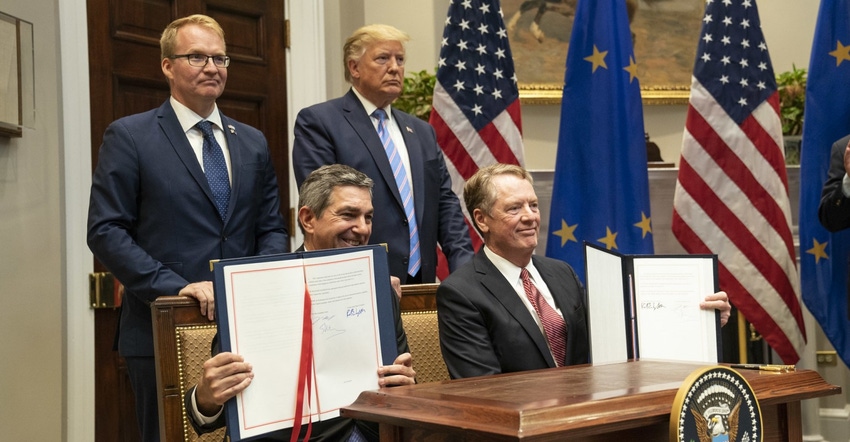Over seven years, tariff rate quota will grow to 35,000 metric tons annually, valued at approximately $420 million.

The United States will be able to nearly triple its annual duty-free exports of beef to the European Union (EU) over the next seven years under a new agreement signed Aug. 2 at the White House. According to the U.S. Trade Representative, the European Union has signed a Memorandum of Understanding raising quotas on U.S. beef products to 35,000 metric tons or $420 million annually.
American ranchers will be guaranteed a bigger share of Europe’s beef market, with annual duty-free exports expected to grow from $150 million to $420 million when the agreement is fully implemented.
“American ranchers produce the best beef in the world. Thanks to President Trump’s leadership, this new agreement ensures that American ranchers can sell more of that beef to Europe,” said U.S. Trade Representative Robert Lighthizer, who signed the agreement with the Honorable Jani Raappana of Finland, representing the Presidency of the EU, and Ambassador Stavros Lambrinidis of the Delegation of the EU.
The new agreement establishes a duty-free tariff rate quota (TRQ) exclusively for the United States. Under the agreement, American ranchers will have an initial TRQ of 18,500 metric tons annually, valued at approximately $220 million. Under the current agreement, U.S. duty-free beef exports to the EU are only approximately 13,000 metric tons annually, valued at approximately $150 million, and risked declines going forward.
In 2016, the National Cattlemen’s Beef Assn., U.S. Meat Export Federation, and the North American Meat Institute requested USTR to take tariff action under Section 301 of the Trade Act of 1974 to enforce the World Trade Organization dispute finding in favor of the United States against the EU’s ban on the use of hormones in cattle production. USTR held a public hearing on February 15, 2017.
Negotiations resulted in a new agreement, which was approved by the European Council on July 15, 2019. It will go into effect following the European Parliament’s approval, which is expected this fall. With the EU providing a country specific duty-free quota for U.S. beef, the United States has agreed as a part of the agreement signed to conclude the proceedings under Section 301 of the Trade Act of 1974 initiated in December 2016.
Senate Agriculture Committee chairman Pat Roberts (R., Kan.) said the agreement will provide much needed relief to producers during an uncertain trading atmosphere. “I appreciate the Administration acting on my decades-long persistence in pushing for greater access for U.S. beef in the EU. I look forward to the upcoming EU Parliament vote to seal this deal.”
U.S. Meat Export Federation (USMEF) President and CEO Dan Halstrom, who participated in the White House ceremony, stated this agreement provides more reliable and consistent access to the EU market and will be a tremendous boost for the U.S. beef industry.
“The agreement sends a very positive signal to customers in Europe who see a bright future for U.S. beef and to producers who are interested in expanding their non-hormone treated cattle (NHTC) business but have grown frustrated as they struggled to recover the additional production costs. USMEF greatly appreciates the tireless efforts of USTR and USDA to secure better access to this very high-value beef market,” Halstrom said.
“America’s ranchers welcome the opportunity to supply a bigger share of Europe’s beef market. This agreement advances a three-decade long effort to expand market opportunities for American agriculture in the EU, and every victory counts,” said Zippy Duvall, American Farm Bureau Federation president.
Duvall noted, however, “While this is certainly good news, it’s important for U.S. negotiators to remain committed to reaching a broad trade agreement with the EU that levels the playing field for all farmers and ranchers.” The U.S. exports $1 trillion of trade goods and services to the EU annually. In 2018, the U.S. exported $12.7 billion in agricultural products to the EU while the EU exported $23.7 billion in agricultural products to the U.S.
North American Meat Institute president and chief executive officer Julia Anna Potts added, “We look forward to continuing to work with the Administration to further reduce barriers impeding, and improve access for, U.S. meat and poultry exports in all foreign markets. It is critical to continue ongoing trade negotiations with China, to approve the United States-Mexico-Canada Agreement (USMCA) and to further talks with Japan.
About the Author(s)
You May Also Like




.png?width=300&auto=webp&quality=80&disable=upscale)
